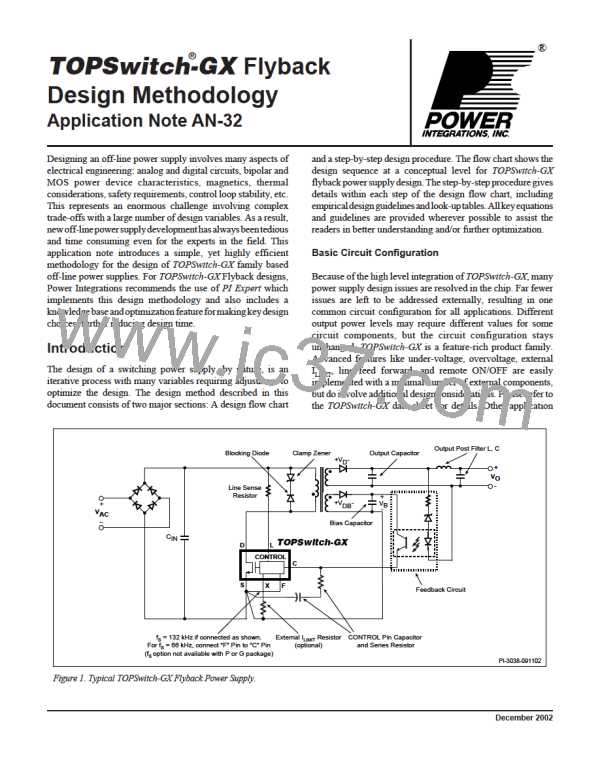AN-32
Customization of secondary designs for each output
The turns for each secondary winding are calculated based on
the respective output voltage VO(n):
Appendix A
Multiple Output Flyback Power
Supply Design
VO(n) + VD(n)
NS(n) = NS ×
The only difference between a multiple output flyback power
supply and a single output flyback power supply of the same
total output power is in the secondary side design. Instead of
delivering all power to one output as in the single output case,
a multiple output flyback distributes its output power among
severaloutputs.Therefore,thedesignprocedurefortheprimary
side stays the same, while that for the secondary side demands
further considerations.
V + VD
Output rectifier maximum inverse voltage is
NS (n)
PIV (n) = VMAX
×
+ VO(n)
S
NP
With output RMS current ISRMS(n), secondary number of turns
NS(n) and output rectifier maximum inverse voltage PIVS(n)
known, the secondary side design for each output can now be
carried out exactly the same way as for the single output design.
Design with lumped output power
One simple way of doing multiple output flyback design is
described in detail in AN-22, “Designing Multiple Output
FlybackPowerSupplieswithTOPSwitch”. Thedesignmethod
starts with a single output equivalent by lumping output power
ofalloutputstoonemainoutput.SecondarypeakcurrentISP and
RMS current ISRMS are derived. Output average current IO
corresponding to the lumped power is also calculated.
Secondary winding wire size
TheTOPSwitch-GXdesignspreadsheetassumesaCMAof200
whencalculatingsecondarywindingwirediameters.Thisgives
the minimum wire sizes required for the RMS currents of each
output using seperate windings. Designers may wish to use
larger size wire for better thermal performance. Other
considerations such as skin effect and bobbin coverage may
suggest the use of a smaller wire by using multiple strands
wound in parallel. In addition, practical considerations in
transformer manufacturing may also dictate the wire size.
Assumption for simplification
The current waveforms in the individual output windings are
determinedbytheimpedanceineachcircuit,whichisafunction
of leakage inductance, rectifier characteristics, capacitor value
and most importantly, output load. Although this current
waveform may not be exactly the same from output to output,
it is reasonable to assume that, to the first order, all output
currents have the same shape as for the single output equivalent
of lumped power.
Output RMS current vs. average current
The output average current is always equal to the DC load
current, while the RMS value is determined by current wave
shape. Since the current wave shapes are assumed to be the
sameforalloutputs, theirratioofRMStoaveragecurrentsmust
also be identical. Therefore, with the output average current
known, the RMS current for each output winding can be
calculated as
ISRMS
ISRMS(n) =IO(n) ×
IO
where ISRMS(n) and IO(n) are the secondary RMS current and
output average current of the nth output and ISRMS and IO are the
secondary RMS current and output average current for the
lumped single output equivalent design.
B
12/02
15

 ETC [ ETC ]
ETC [ ETC ]